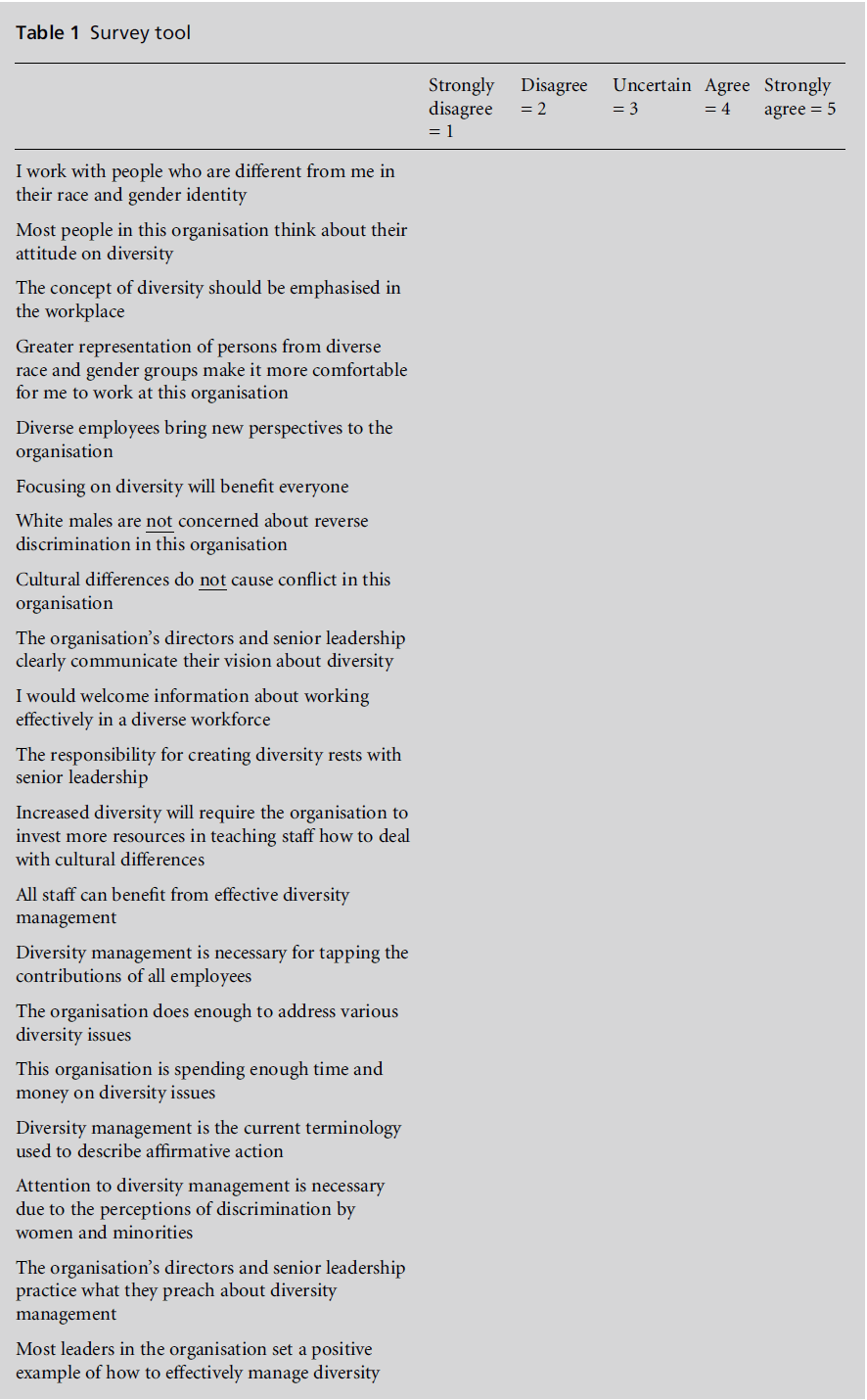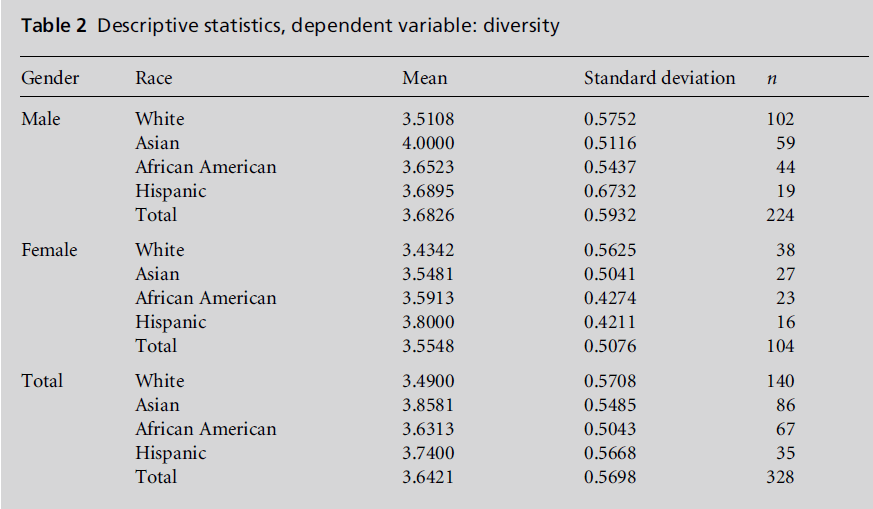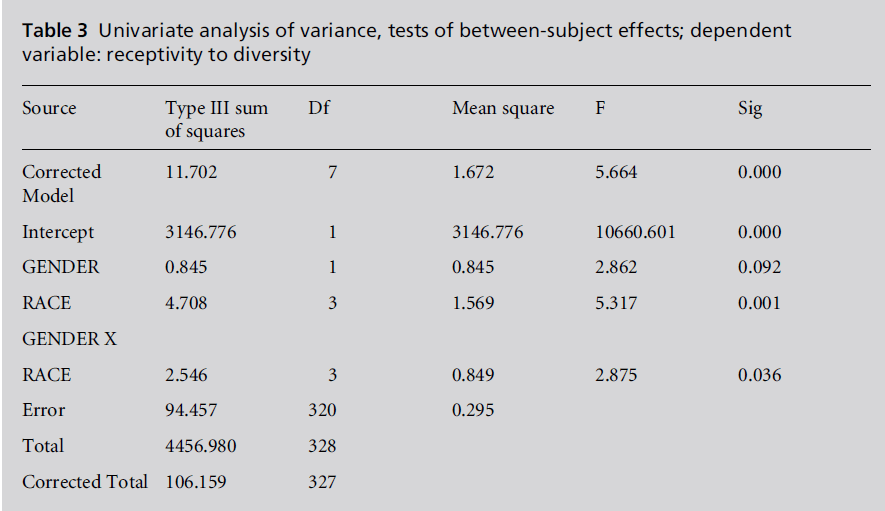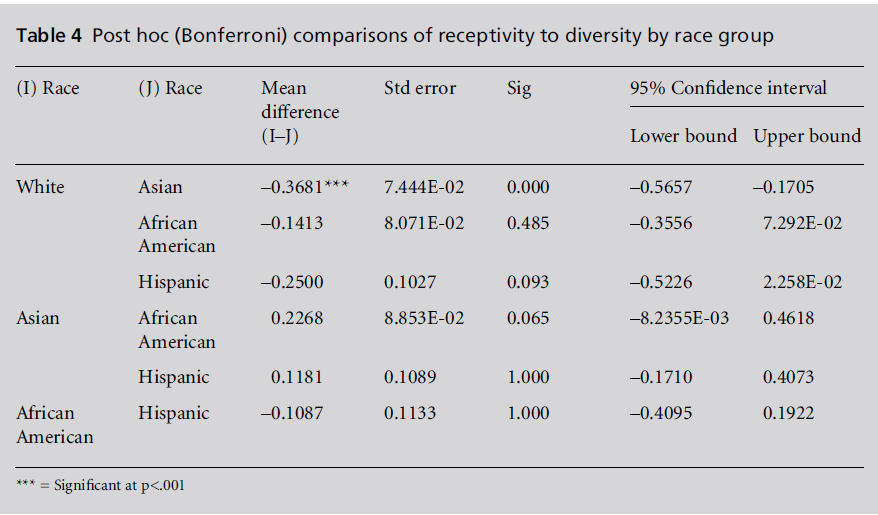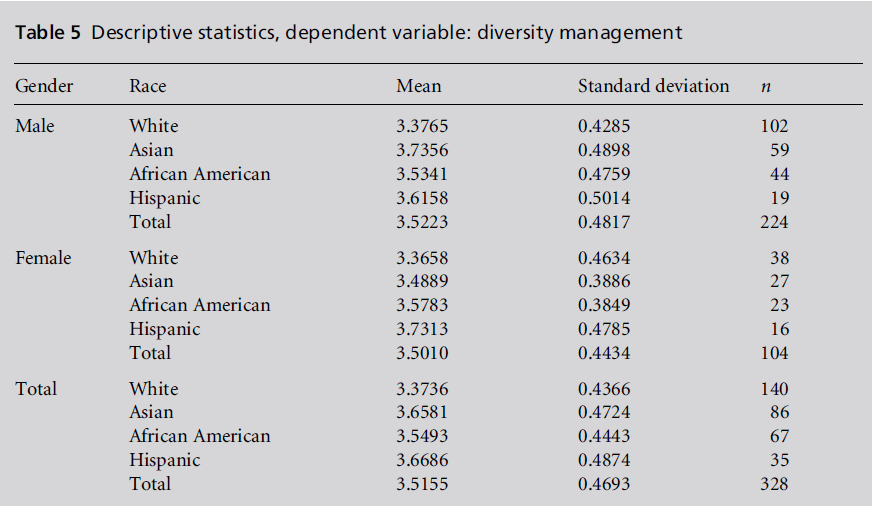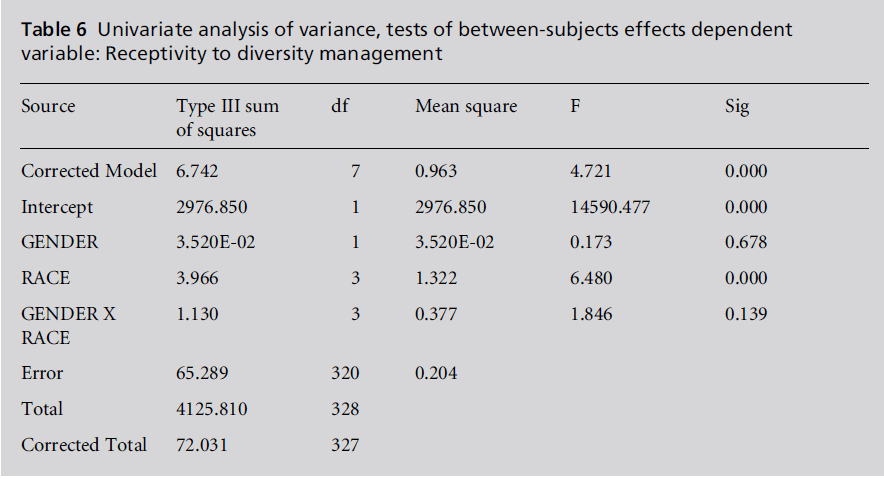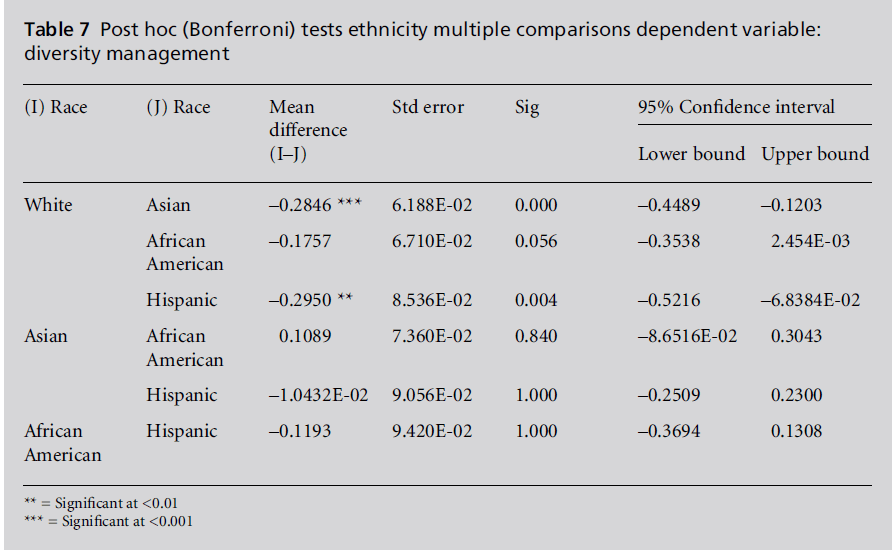Key words
diversity, diversity management, gender,
race
Introduction
The size, distribution and composition of the American
military population ‘continues to reflect demographic
trends that are altering the entire American
population’, a population that continues to become
more diverse each year (Segal and Wechsler-Segal,
2004, p. 37). A Defense Equal Opportunity Management
Institute (DEOMI) report from 2004 to 2010
found a decrease in white male active duty forces and
an increase in minority male active duty forces
(Sudduth, 2011). Although African American female
active duty forces decreased by 6%, white, Hispanic
and American Indian/Alaska Native female active
duty forces increased by 4%, 21% and 12% respectively.
In line with this trend, the US Navy workforce
has become increasingly diverse in terms of gender
and race (Velarde, 2008) and has invested substantial
resources to develop and implement policies that
promote opportunity (Paige, 2011; Metzer, 2013)
and a culture of diverse backgrounds and perspectives
as outlined in the Navy’s Total Force Vision for the
21st Century (US Navy, 2010). Hence a considerable
amount of time is spent measuring diversity-related
factors in the military such as inclusion, benefits,
justice, mentoring, work group effectiveness, work
group cohesion, personal accountability, training
and development, and leadership (Sudduth, 2011).
What is not clear is whether organisational members
subscribe to the value of diversity and to diversity
management initiatives in the Navy. What is known,
from a limited number of studies conducted in the
public sector in the US federal government, is that an
employee’s receptivity to diversity and diversity management
varies between gender and race groups (Soni,
2000; Choi and Rainey, 2010; O’Brien et al, 2010).
Burress et al (2008) found a total of 274 journal
articles and research reports about aspects of race and
gender diversity in the Navy and the other US military
services, citing published research conducted since the
advent of an all-volunteer force in 1973. Of this
number, only 49 articles were directly related to
diversity and an even smaller number, 17, were related
to diversity management. None of these studies focused
on how a culturally diverse workplace and the
support and actions of top management to effectively
manage diversity are perceived by US Navy Hospital
employees. Little research has been published in this
area to date. This is surprising given that behaviour is
in part based on perceptions; therefore, it is important
to understand how employees perceive others and the
actions of top management (Mor Barak, 2005; Holtz
and Harold, 2013). This paper reports on a study that
addressed gaps in the literature by examining the
extent to which receptivity to diversity and receptivity to diversity management vary among US Navy employee
groups.
Receptivity to diversity, gender and
race
Most studies have focused on gender and race differences
in attitudes toward Equal Employment Opportunity/
Affirmative Action (EEO/AA) rather than
diversity (Aguirre et al, 1993; Bobo and Kluegel,
1993; Zdaniuk and Bobocel, 2011). The emphasis on
diversity within the organisation and the role of AA
programmes was found to be a point of considerable
disagreement between minority and majority employees
(Triandis, et al, 1993; Mangum, 2008; Ortega
et al, 2012). Attitudes toward AA policies tend to be
more positive among minorities as compared to
whites (Bobo, 2000; Kravitz and Klineberg, 2000;
Klineberg and Kravitz, 2003; Harrison et al, 2006).
The promotion of multicultural work environments is
based on the premise that such diversity will create
better decision-making in the organisation, greater
creativity, increased competitiveness (Bassett-Jones,
2005; Kravitz et al, 2008; Thomas, 1990) and improved
performance (Knouse, 2003; Cummings, 2004) and
outcomes (Riche, 2005).
Women and minorities are more likely to be
recipients of benefits within the organisation from
policies and procedures that encourage and promote a
more diverse workforce. Conversely, white males may
see themselves as not benefiting from the same policies
that affect the power structure and resource allocation
within the organisation (Kossek and Zonia, 1994;
Hansken and Tippins, 2012). This can lead to resentment,
disruption in the workplace (Parvis, 2005),
resistance and stereotypes, which damage intergroup
relations.
Receptivity to diversity management,
gender and race
Previous research points to the existence of gender and
race differences in perceptions of discrimination in
organisations which can affect how employees view
and support diversity management programmes. For
example, many Blacks assume that most Whites are
prejudiced (Triandis, 1976; Appiah, 2011; Irizarry,
2013), and consequently, people of colour perceive
their race as a barrier in their advancement (Jones,
1986; Worsley and Stone, 2011). Vinson and Holloway
(1977) found that Blacks see less discrimination in
organisations that have formal rules for hiring and
firing as opposed to none at all. They assume that if the
supervisor has discretion, they will be subjected to
discrimination. This perception or their reality may
still be viewed as an issue by members of some minorities (Crosby and Clayton, 2004; Evans and
Chun, 2007; Bendick and Nunes, 2012). Alderfer et al
(1980) and Khosrovani and Ward (2011) suggest that
women and minorities receive fewer opportunities for
training and development to prepare them for additional
responsibilities. Black employees may believe
that they receive less important career information
than do their White counter-parts (Zajac, 2011;
Trueland, 2012). Triandis et al (1993) found that
members of minority groups often perceive ambiguous
behaviours as prejudice. It is also thought that
women tend to have less access to a variety of important
resources in organisations than do men.
Potential advancement is limited in scope and
frequency for women and minorities. EEO/AA polices
are not designed, or at least not perceived to be
designed, for all employees. It may be expected that
members of different groups, particularlywhite males,
will have different reactions to EEO/AA policies in an
organisation (Bobo and Kluegel, 1993; Graves and
Powell, 1994; Harrison et al, 2006). Members of
minority groups perceive themselves to benefit from
identity group programmes, white men may not and
may even regard diversity management initiatives as
harmful (Kidder et al, 2004). In testing a new theoretical
model of receptivity to diversity, Soni (2000)
identified significant and meaningful differences in
how white males and females, as opposed to minority
males and females, view diversity and diversity management
initiatives. However there is very little empirical
evidence about whether or not organisational
members within specific race groups in fact subscribe
to the value of diversity and employer-supported
diversity management initiatives.
This study provided an opportunity to better
understand the Soni (2000) findings and their potential
to be replicated in a new setting, by determining
the extent to which employees’ receptivity to diversity
and receptivity to diversity management initiatives
varied by gender and ethnicity. Unlike the Soni study
that amalgamated race groups into majority (White)
and minority (such as African American, Hispanic),
this study treated each race group as a separate
category for analysis.
Research aims
To ascertain the extent to which employees’ receptivity
to diversity and diversity management initiatives
varies by gender and race.
Methods
Procedure
The study was conducted in the largest overseas
hospital in the US Navy. The chair of the Institutional
Review Board confirmed that the study did not
require ethical review. Permission for this research
was approved in an effort to support academic research,
provide access to a relevant study population,
and use the results for process improvement initiatives
to strengthen the effectiveness of work teams, diversity
policies and diversity programmes.
The intention was to replicate Soni’s (2000) study
using her survey tool developed to test a theoretical
model of receptivity to diversity (Table 1). She
constructed the survey tool using two different dimensions,
receptivity to diversity, and receptivity to
diversity management initiatives. The survey tool was
slightly modified for difference in organisational
terms (from Agency Top Administrators to Organisation
Directors and Senior Leadership). The content
of the questions remained the same. Soni (2000)
developed these indices based on her understanding
of the theory underlying receptivity to diversity and
diversity management. Soni (2000) reported adequate
reliability (Cronbach’s alpha coefficient for the indexes
ranged from 0.8 to 0.9).This range demonstrated a
moderate to high level of internal consistency. Content
validity was used in the study as the validity
criterion for the instrument. This provides a reasonable
foundation on which to build a methodological
assessment of the survey instrument’s validity (Litwin,
1995).
The 20 questions captured the variables of interest,
receptivity to diversity and receptivity to diversity
management using a five-point Likert scale (Table 1).
The first 10 questions were used to obtain a receptivity
to diversity score. The second 10 questions were used
to obtain a receptivity to diversity management score.
The survey was administered by mail with an introductory
cover letter containing the purpose of the
study, a request for cooperation and a promise of
anonymity mailed to each member of the organisation
with a request for returns within 30 days.
The address and (free to employees) Military Postal
Service name was provided with each survey. All
surveys were sent to the mailbox of each member of
the organisation with a request to return the survey.
An email was sent to all hospital staff to let them know
a surveywas sent to them, the purpose of the study and
the importance of their response. Staff members were
told that for each survey received, one US dollar would
be donated to a local orphanage. The US military and
civilian population maintains close ties with the local
community. The rationale was that people would be willing to complete the survey if they were earning
money for a charity initiative.
Ten days after the original mailing a follow-up
message was sent via email to all staff members. Two
more follow-up emails were sent at 10-day intervals.
The surveys were received and screened by a neutral
third party who removed any information that might
personally identify a respondent. Once anonymitywas
safeguarded, the neutral party forwarded the survey
information to the researcher for data processing.
Demographics were divided into eight categories:
gender (male and female), race (White, Asian, African
American and Hispanic).
The data were analysed using descriptive statistics.
Univariate Analysis of Variance(ANOVA)was used to
examine the relationships between:
• Receptivity to diversity and gender/race (whether
receptivity scores varied significantly by gender/
race)
• Receptivity to diversity management and gender/
race (whether receptivity scores varied significantly
by gender/race).
Sample
All 894 employees, both Navy and civilian personnel,
were invited to participate in the study, with assurances
that this was completely voluntary and anonymous.
A total of 328 responded, yielding a 37%
response rate. This was considered to be an acceptable
return rate.
Of the 328 participants, male employees composed
the largest group by gender at 68.3%. Most respondents
(42.7%) were white, while 26.2% were Asian,
20.4% were African American, and the remaining
10.7% Hispanic. No other race groups were represented
within the organisation at the time of the study
such as Pacific Islander, American Indians, Alaska
Natives or other. These percentages were proportionate
to those in the whole employee population.
Findings
Receptivity to diversity
Table 2 shows means and standard deviations of the
receptivity to diversity score for gender and ethnic
groups. Table 3 shows the ANOVA of the receptivity
to diversity score with ethnic group and gender as
independent variables. The race group were found to
differ significantly in receptivity to diversity [F(3, 320)
= 5.317, P=0.001]. A Bonferroni multiple comparisons
procedure was conducted to determine which
means were significantly different across race. Asian
employees were found to be significantly more receptive
to diversity than white employees. The significant
main effect for race was qualified by an interaction
effect between gender and race whereby, as a group,
male Asian employees reported greater receptivity to
diversity than white employees when compared with
female Asian employees (Table 4).
Table 2:Descriptive statistics, dependent variable: diversity.
Table 3:Univariate analysis of variance, tests of between-subject effects; dependent
variable: receptivity to diversity.
Table 4:Post hoc (Bonferroni) comparisons of receptivity to diversity by race group.
Receptivity to diversity management
Table 5 shows means and standard deviations of the
receptivity to diversity management score with ethnic
group and gender as independent variables. The
ANOVA results indicate that receptivity to diversity
management differed significantly across race F(3,
320) = 6.480, P<0.001 (Table 6). A Bonferroni multiple
comparisons procedure was conducted to determine
which means were significantly different from one another (Table 7). The results show significant
differences between white and Asian and between
white and Hispanic ethnic groups. The difference
between white and African American just failed to
reach significance.No differences among the minority
groups reached significance.
Table 5:Descriptive statistics, dependent variable: diversity management.
Table 6:Univariate analysis of variance, tests of between-subjects effects dependent
variable: Receptivity to diversity management.
Conclusion and implications
This study examined the extent to which employees’
receptivity to diversity and diversity management
varied by gender and race groups, replicating Soni’s
previously tested Receptivity to Diversity and Receptivity
to Diversity Management Indices (2000). More
specifically, this study was of staff in an overseas US
Navy hospital. Diversity research was found to be
lacking between gender and race groups with respect to receptivity to diversity and receptivity to diversity
management.
Contrary to the Soni (2000) findings, no significant
difference was found between female and male employees
in their receptivity to diversity. There was an
interaction effect between ethnicity and gender with
regard to receptivity to diversity in that male Asian
employees reported greater receptivity to diversity
than Whites. Female Asian employees were less receptive
to diversity than male Asian employees.
Table 7:Post hoc (Bonferroni) tests ethnicity multiple comparisons dependent variable:
diversity management.
The lack of a significant main effect for gender on
either dependent variable may represent a selection
effect due to the military environment studied. Females
that work in a male-dominated environment,
such as the military, may be those that have less
traditionally feminine identities and thus, do not
perceive the personal benefit of treating gender as a
target for diversity management interventions. This
lack of differences could also reflect the success of
Navy medicine in promoting the work and value of
female personnel. The absence of a statistically significant
gender finding could also be the levelling result of
a rule-oriented and compliance-driven environment
where mandated equal employment opportunity training
and regular command climate evaluations are the
norm.
It is also arguable that the training of recruits and
subsequent operational experiences provided by the
US Navy offer some of the most effective approaches
to managing diversity seen in large organisations. The
US Navy builds cohesive units out of diverse groups of
individuals during training, emphasising the importance
of teamwork in overcoming obstacles. Strong
bonds are often forged through overcoming shared
adversity. Moreover, early on in the induction to Navy
life, personnel are taught a set of unified values more
commonly referred to as core values: honour, courage
and commitment. These core values may moderate
attitudinal differences based on gender and race. Such
a team-oriented society may engender respect and
appreciation for the unique skills and perspectives
brought to bear on shared problems by team members from diverse backgrounds. As such, there may be a
general level of acceptance and appreciation for diversity
that mitigates most between-group differences.
However, the benefits of these experiences may be
limited as differences between race groups became
stronger when receptivity to diversity management
was examined. In other words, the hypothesised
respect for diversity inherent in the military culture
may only go as far as leveling people’s openness to
diversity but not to diversity management. When it
came to endorsing diversity initiatives in the workplace,
Hispanic and Asian American employees were
significantly more receptive to these than white employees.
A similar, though statistically insignificant
pattern, was seen for African Americans compared to
Whites.
There is still one question that needs to be
reconciled. Why was the difference in receptivity to
diversity more pronounced between white and Asian
American employees as opposed to the other race
groups? This is an interesting finding since the literature
(Kravitz and Platania, 1993; Bell et al, 1997; Bobo,
1998; Kravitz and Klineberg, 2000) suggests that Asian
American employees are generally less receptive to
diversity than Hispanic and African American employees,
but more receptive to diversity than white
employees. No evidence of differences among minority
ethnic groups was found.
Most of the Asian employees in the study were born
in the Philippines. As a subpopulation within the
category of Asian Americans, they are likely to have
unique characteristics, which warrant further study as a separate group. Additionally, a post-survey interview
of some of the Asian American employees
revealed that some had past experiences with discrimination
and valued different cultures and heterogeneous
teams. The location of the institutional setting in
Okinawa, Japan, also deserves mention. The embedding
of a Western-based institution in an Eastern
culture may have highlighted cultural differences that
were more salient to Asian Americans than to other
minorities.
Lastly, qualitative data collected in the form of post
survey interviews underscored the differences in the
receptivity to diversity management means between
white employees and Asian and Hispanic employees.
Many Asian and Hispanic employees reported that
they thought diversity management policies and programmes
were necessary in the workplace. Some
commented that programmes ‘let people know they
need to treat others fairly’ and that ‘[the organisation
is] simply open to diversity.’ In fact, some respondents
believed that diversity policies and programmes assisted
them with their advancement.
Limitations and directions for future
research
The Hispanic population in this study was small,
comprising 8–9% of the hospital population, which
may limit generalisation to other settings. There is
some evidence to suggest that individuals can differ in
the extent to which their group membership is central
and salient to their self-concept. The study confined
itself to surveying civilian and military employees of
an overseas US Navy hospital and while the authors
believe this sample to be reasonably representative of
other employee populations in US military hospitals,
caution is recommended in generalising these findings
to other settings
The findings of the current study shed some light on
important questions for future research studies to
address. First, as the current study is the first in a US
Navy hospital, future studies can be extended to other,
similar organisations to validate the findings. Secondly,
findings may have been affected by limited demographic
questions. Future research could be extended to
include other dimensions of diversity such as position
level (supervisor or non-supervisor), age, organisational
tenure, employment classification (military or civilian),
and education level. Finally, it is suggested that future
studies utilise larger and more balanced samples within
gender and race groups to examine the differences
between these groups.
Implications for managers
As styled earlier, it is estimated that the population of
the US will increase to 438 million in 2050 from 296
million in 2005, and 82% of this increase will be due to
immigrants arriving from 2005 to 2050 and their USborn
descendants (Passel and D’Vera Cohn, 2008).
These figures challenge organisational leaders to influence
everyone to want to work together as an
effective and efficient team. As workplace diversity increases
in organisations, so will the possibility of
problems between members of different cultures.
Leaders who understand this upfront can help temper
adverse effects on the staff and on the organisation as a
whole. Hiring staff, especially leaders, who value differences,
focusing on team building, offering diversity
training, developing policies and programmes that
recognise differences but share a common goal towards
unity, conducting periodic culture audits and sharing
results with staff are all ways to improve receptivity to
diversity and to achieve and maintain diversity management.
Conclusion
In total, the US Navy Hospital is comprised of a
diverse workforce that largely embraces the concept
of diversity and diversity management. The findings
of this study found no significant difference between
female and male employees in their receptivity to
diversity. Further study regarding affirmative action
policies is needed to further understand the perceptions
of more specific ethnic groups.
CONFLICTS OF INTEREST
None.
References
- Aguirre A, Martinez R, Hernandez A (1993) Majority and minority faculty perceptions in academia. Research in Higher Education 34:371ÃÆÃâÃââÃÆââ¬Å¡Ã¢ââ¬Å¡Ã¬ÃÆââ¬Å¡Ã¢ââ¬Ã
â85.
- Alderfer C, Alderfer C, Tucker L et al (1980) Diagnosing race relations in management. Journal of Applied Psychology 56(6):456ÃÆÃâÃââÃÆââ¬Å¡Ã¢ââ¬Å¡Ã¬ÃÆââ¬Å¡Ã¢ââ¬Ã
â60.
- Appiah KA (2011). Group rights and racial affirmative action. Journal of Ethics 15:265ÃÆÃâÃââÃÆââ¬Å¡Ã¢ââ¬Å¡Ã¬ÃÆââ¬Å¡Ã¢ââ¬Ã
â80.
- Bassett-Jones N (2005) The paradox of diversity management, creativity and innovation. Creativity and Innovation Management 14(2):169ÃÆÃâÃââÃÆââ¬Å¡Ã¢ââ¬Å¡Ã¬ÃÆââ¬Å¡Ã¢ââ¬Ã
â75.
- Bell M, Harrison D, McLaughlin M (1997) Asian American attitudes toward affirmative action in employment: Implications for the model minority myth. Journal of Applied Behavioral Science 33:356ÃÆÃâÃââÃÆââ¬Å¡Ã¢ââ¬Å¡Ã¬ÃÆââ¬Å¡Ã¢ââ¬Ã
â77.
- Bendick M, Nunes A P (2012). Developing the research basis for controlling bias in hiring. Journal of Social Issues 68(2): 238ÃÆÃâÃââÃÆââ¬Å¡Ã¢ââ¬Å¡Ã¬ÃÆââ¬Å¡Ã¢ââ¬Ã
â62.
- Bobo L (1998) Race, interests, and beliefs about affirmative action. American Behavioral Scientist, 41:985ÃÆÃâÃââÃÆââ¬Å¡Ã¢ââ¬Å¡Ã¬ÃÆââ¬Å¡Ã¢ââ¬Ã
â1003.
- Bobo L (2000) Race and beliefs about affirmative action: Assessing the effects of interest, group threats, ideology, and racism. In: DO Sears, J Sidanius and L Bobo (eds), Racialized politics: The debate about racism in America (137ÃÆÃâÃââÃÆââ¬Å¡Ã¢ââ¬Å¡Ã¬ÃÆââ¬Å¡Ã¢ââ¬Ã
â64), Chicago: University of Chicago Press.
- Bobo L, Kluegel J (1993) Opposition to race ÃÆÃâÃââÃÆââ¬Å¡Ã¢ââ¬Å¡Ã¬ÃÆââ¬Å¡Ã¢ââ¬Ã
â targeting:Selfinterest, stratification ideology, or race attitudes? American Sociological Review 58:443ÃÆÃâÃââÃÆââ¬Å¡Ã¢ââ¬Å¡Ã¬ÃÆââ¬Å¡Ã¢ââ¬Ã
â64.
- Burress L, Uriell Z, Kee A (2008) Annotated bibliography of diversity research issues in the Navy and US military. Navy PersonnelResearch, Studies, andTechnologyDivision, Bureau of Navy Personnel (NPRST/PERS-1). NPRST-TN-08ÃÆÃâÃââÃÆââ¬Å¡Ã¢ââ¬Å¡Ã¬ÃÆââ¬Å¡Ã¢ââ¬Ã
â6. www.deomi.org/DiversityMgmt/documents/Bibliography ofDiversityissueforDRN.pdf
- Choi S, Rainey H (2010) Managing diversity in US federal agencies: Effects of diversity and diversity management on employee perceptions of organisational performance. Public Administration Review 70(1):109ÃÆÃâÃââÃÆââ¬Å¡Ã¢ââ¬Å¡Ã¬ÃÆââ¬Å¡Ã¢ââ¬Ã
â21.
- Crosby FJ and Clayton S (2004) Affirmative action and the search for educational equity. Analyses of Social Issues and Public Policy 4(1):243ÃÆÃâÃââÃÆââ¬Å¡Ã¢ââ¬Å¡Ã¬ÃÆââ¬Å¡Ã¢ââ¬Ã
â49.
- Cummings J (2004) Work groups, structural diversity, and knowledge sharing in a global organisation. Management Science 50(3):352ÃÆÃâÃââÃÆââ¬Å¡Ã¢ââ¬Å¡Ã¬ÃÆââ¬Å¡Ã¢ââ¬Ã
â64.
- Evans A, Chun E (2007). Are the walls really down? Behavioral and organisational barriers to faculty and staff diversity. AHE Higher Education Report 33(1). Gall M, Borg W, Gall J (1996) Educational research: An introduction (6th ed). White Plains, NY: Longman Publishing.
- Graves L, Powell G (1994) Effects of sex-based preferential selection and discrimination on job attitudes. Human Relations 47:133ÃÆÃâÃââÃÆââ¬Å¡Ã¢ââ¬Å¡Ã¬ÃÆââ¬Å¡Ã¢ââ¬Ã
â57.
- Hansken L, Tippins S (2012) Perceptions of white males toward affirmative action conflict. Resolution and Negotiation Journal 2:121.
- HarrisonDA, KravitzDA, MayerDM, Leslie LM, Lev-Arey D (2006) Understanding attitudes toward affirmative action programs in employment: Summary and metaanalysis of 35 years of research. Journal of Applied Psychology 91: 1013ÃÆÃâÃââÃÆââ¬Å¡Ã¢ââ¬Å¡Ã¬ÃÆââ¬Å¡Ã¢ââ¬Ã
â36.
- Holtz B, Harold C (2013) Effects of leadership consideration and structure on employee perceptions of justice and counterproductive work behavior. Journal of Organisational Behavior, 34:492ÃÆÃâÃââÃÆââ¬Å¡Ã¢ââ¬Å¡Ã¬ÃÆââ¬Å¡Ã¢ââ¬Ã
â519.
- Irizarry Y (2013) Is measuring interracial contact enough? Racial concentration, racial balance, and perceptions of prejudice among black Americans. Social Science Quarterly 94(3).
- Jones E (1986) Black managers: The dream deferred. Harvard Business Review 64:84ÃÆÃâÃââÃÆââ¬Å¡Ã¢ââ¬Å¡Ã¬ÃÆââ¬Å¡Ã¢ââ¬Ã
â93. Joyce J (2013) Diversity and 95 years of Naval Weapons Technology Celebrated at Dahlgren Naval Base. www. navy.mil/submit/display.asp?story_id=77125
- Kidder D, Lankau M, Chrobot-Mason D et al (2004) Backlash toward diversity initiatives: Examining the impact of diversity program justification, personal and group outcomes. International Journal of Conflict Management 15(1), 77ÃÆÃâÃââÃÆââ¬Å¡Ã¢ââ¬Å¡Ã¬ÃÆââ¬Å¡Ã¢ââ¬Ã
â102.
- Khosrovani M, Ward J (2011). African AmericansÃÆÃâÃââÃÆââ¬Å¡Ã¢ââ¬Å¡Ã¬ÃÆââ¬Å¡Ã¢ââ¬Å¾Ã¢ perceptions of access to workplace opportunities: A survey of employees in Houston, Texas. Journal of Cultural Diversity, 18(4)
- Klineberg S, Kravitz D (2003) Ethnic differences in predictors of support for municipal affirmative action contracting. Social Science Quarterly 84(2):425ÃÆÃâÃââÃÆââ¬Å¡Ã¢ââ¬Å¡Ã¬ÃÆââ¬Å¡Ã¢ââ¬Ã
â40.
- Knouse S, Stewart J (2003) Hard measures that support the business case for diversity: A Balanced Scorecard approach. The Diversity Factor 11(4):5ÃÆÃâÃââÃÆââ¬Å¡Ã¢ââ¬Å¡Ã¬ÃÆââ¬Å¡Ã¢ââ¬Ã
â11.
- Kossek E, Zonia S (1994) The effects of race and ethnicity on perceptions of human resource policies and climate regarding diversity. Journal of Business and Technical Communication 8(3):319ÃÆÃâÃââÃÆââ¬Å¡Ã¢ââ¬Å¡Ã¬ÃÆââ¬Å¡Ã¢ââ¬Ã
â35.
- Kravitz D, Klineberg S (2000) Reactions to two versions of affirmative action among White, Blacks, and Hispanics. Journal of Applied Psychology 85:597ÃÆÃâÃââÃÆââ¬Å¡Ã¢ââ¬Å¡Ã¬ÃÆââ¬Å¡Ã¢ââ¬Ã
â611.
- Kravitz D, Platania J (1993) Attitudes and beliefs about affirmative action: Effects of target and of respondent sex and ethnicity. Journal of Applied Psychology 78:928ÃÆÃâÃââÃÆââ¬Å¡Ã¢ââ¬Å¡Ã¬ÃÆââ¬Å¡Ã¢ââ¬Ã
â938.
- Kravitz DA, Bludau TM, Klineberg SL (2008) The impact of anticipated consequences, respondent group, and strength of affirmative action plan on affirmative action attitudes. Group and Organisation Management 33:361ÃÆÃâÃââÃÆââ¬Å¡Ã¢ââ¬Å¡Ã¬ÃÆââ¬Å¡Ã¢ââ¬Ã
â 91.
- Mangum M (2008). Testing competing explanations of Black opinions on affirmative action. The Policy Studies Journal 36(3).
- Metzer J (2013) Women in Subs: A Shaper Warfighting Edge. cno.navylive.dodlive.mil
- MorBarakM(2005) Managing Diversity: Toward a Globally Inclusive Workplace. Thousand Oaks: Sage Publications.
- Nathan M (2013) Navy Medicine Diversity. www.med.navy.mil/diversity/Pages/default_old.aspx
- OÃÆÃâÃââÃÆââ¬Å¡Ã¢ââ¬Å¡Ã¬ÃÆââ¬Å¡Ã¢ââ¬Å¾Ã¢Brien L T, Garcia D, Crandall CS, Kordys J (2010). White AmericansÃÆÃâÃââÃÆââ¬Å¡Ã¢ââ¬Å¡Ã¬ÃÆââ¬Å¡Ã¢ââ¬Å¾Ã¢ opposition to affirmative action: Group interest and the harm to beneficiaries objection. British Journal of Social Psychology 49:895ÃÆÃâÃââÃÆââ¬Å¡Ã¢ââ¬Å¡Ã¬ÃÆââ¬Å¡Ã¢ââ¬Ã
â903.
- Ortega R, Plagens G, Stephens P, Berry-James R (2012) Mexican American public sector professionals: Perceptions of affirmative action policies and workplace discrimination. Review of Public Personnel Administration 32(1):24ÃÆÃâÃââÃÆââ¬Å¡Ã¢ââ¬Å¡Ã¬ÃÆââ¬Å¡Ã¢ââ¬Ã
â44.
- Parvis L (2005). Diversity and effective leadership in multicultural workplaces. Journal of Environmental Health.
- Paige P (2011) ONR Promotes NavyÃÆÃâÃââÃÆââ¬Å¡Ã¢ââ¬Å¡Ã¬ÃÆââ¬Å¡Ã¢ââ¬Å¾Ã¢s Diverse Opportunities at Conference. Retrieved from www.navy.mil/submit/ display.asp?story_id=59519
- Passel J, Cohn D (2008) US Population Projections: 2005ÃÆÃâÃââÃÆââ¬Å¡Ã¢ââ¬Å¡Ã¬ÃÆââ¬Å¡Ã¢ââ¬Ã
â 2050. Pew Research Center, Social and Demographic Trends. www.pewhispanic.org/2012/11/14/references-5
- Riche M, Kraus A, Hodari A et al (2005) Literature Review: Empirical Evidence Supporting the Business-Case Approach to Workforce Diversity (CRM D0011482.A2). Alexandria, VA: The CNA Corporation.
- Segal D, Wechsler Segal M (2004) AmericaÃÆÃâÃââÃÆââ¬Å¡Ã¢ââ¬Å¡Ã¬ÃÆââ¬Å¡Ã¢ââ¬Å¾Ã¢s Military Population Bulletin 59(4).
- Soni V (2000) A twenty-first century reception for diversity in the public sector: A case study. Public Administration Review 60(5):395ÃÆÃâÃââÃÆââ¬Å¡Ã¢ââ¬Å¡Ã¬ÃÆââ¬Å¡Ã¢ââ¬Ã
â403.
- Sudduth M (2011) Demographic Trend Summary Representation of Race/Ethnic Groups and Women in the Active Armed Forces 2004ÃÆÃâÃââÃÆââ¬Å¡Ã¢ââ¬Å¡Ã¬ÃÆââ¬Å¡Ã¢ââ¬Ã
â2010. Defense Equal Opportunity Management Institute, Directorate of Research. www.deomi.org/downloadableFiles/Deomgraphic_ Trend_Summary_2004_to_2010_Sudduth.pdf Thomas R (1990) From affirmative action to affirming diversity. Harvard Business Review 107ÃÆÃâÃââÃÆââ¬Å¡Ã¢ââ¬Å¡Ã¬ÃÆââ¬Å¡Ã¢ââ¬Ã
â77.
- Triandis H, Kurowski L, Tecktiel A et al (1993) Extracting the emics of diversity. International Journal of Intercultural Relations 17:217ÃÆÃâÃââÃÆââ¬Å¡Ã¢ââ¬Å¡Ã¬ÃÆââ¬Å¡Ã¢ââ¬Ã
â34.
- TriandisH(1976) Variations in black and white perceptions of the social environment. Urbana: University of Illinois. In: Mor Barak M, Cherin D and Berkman S (1998) Organisational and personal dimensions in diversity climate. Journal of Applied Behavioral Science 34(1):82ÃÆÃâÃââÃÆââ¬Å¡Ã¢ââ¬Å¡Ã¬ÃÆââ¬Å¡Ã¢ââ¬Ã
â 104.
- Trueland J (2012). Unequal opportunities. Nursing Standard 27(5).
- US NavyÃÆÃâÃââÃÆââ¬Å¡Ã¢ââ¬Å¡Ã¬ÃÆââ¬Å¡Ã¢ââ¬Å¾Ã¢s Total Force Vision for the 21st Century (2010) www.navy.mil/features/NTF%20Vision%20%28Final% 29%2811%20Jan%2010%201210hrs%29
- Velarde M (2008) Behind the Scrubs: A Nursing MagazineÃÆÃâÃââÃÆââ¬Å¡Ã¢ââ¬Å¡Ã¬ÃÆââ¬Å¡Ã¢ââ¬Å¾Ã¢s Representation of Race and Gender (thesis). www.saintmarys.edu/files/Monica%20Velarde.doc
- Vinson E, HollowayN(1977) The effects of formalisation on perceptions of discrimination, effort and performance. Journal of Vocational Behavior 10:302ÃÆÃâÃââÃÆââ¬Å¡Ã¢ââ¬Å¡Ã¬ÃÆââ¬Å¡Ã¢ââ¬Ã
â15.
- Worsley J D, Stone C F (2011). Framing the problem of barriers to upward mobility for African Americans in parks and recreation. Journal of Park and Recreation Administration, 29(2):69ÃÆÃâÃââÃÆââ¬Å¡Ã¢ââ¬Å¡Ã¬ÃÆââ¬Å¡Ã¢ââ¬Ã
â90.
- Zajac L (2011) Double-loop approach: Recruitment and retention of minority nursing faculty. The ABNF Journal 22(3).
- Zdaniuk A, Bobocel D R (2011) Independent self-construal and opposition to affirmative action: The role of microjustice and macrojustice preferences. Social Justice Research 24(4):341ÃÆÃâÃââÃÆââ¬Å¡Ã¢ââ¬Å¡Ã¬ÃÆââ¬Å¡Ã¢ââ¬Ã
â64.

